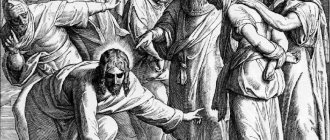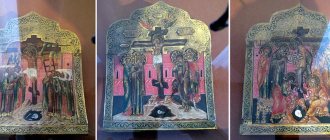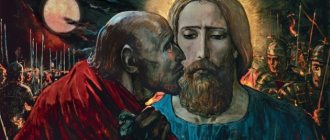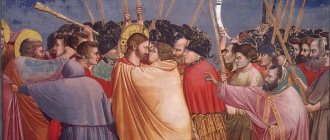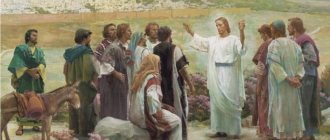Gospel of Judas: Let's Find It Out
In the recent past, a supposed secret revelation, the Gospel of Judas, was announced. First there was the Da Vinci Code, now the Gospel of Judas. Almost immediately it is unclear how the Apostle, who betrayed Jesus Christ and, moreover, killed himself the day before Christ’s crucifixion, could write the Gospel? When was this book written? And if we believe National Geographic, which announced an article about the translation of the Gospel of Judas from the Coptic language, then this is an equivalent Gospel about the life and teachings of Jesus Christ. If this is true, then this radically changes the concept of the relationship between Jesus Christ and His disciples.
In the newly discovered Gospel, Judas is presented as the Apostle closest to Jesus. He is the only one who received special, deep knowledge about the Kingdom of God from Jesus Christ. Is the manuscript really an ancient copy of the Gospel of Judas? What is the main message of this gospel? How does this Gospel relate to Christianity and the accepted canon of Scripture? Does this Gospel give a new perspective on those that already exist - the canonical Gospels?
Is the Gospel of Judas really an ancient manuscript?
Some of you may be hoping it turns out to be a fake. Like it or not, the Gospel of Judas is very real, and the manuscript found in Egypt in 1970 is definitely not a fake. After the discovery of this 26-page manuscript (actually even about 66 pages, including other Gnostic works) due to misunderstanding of its meaning, parts of it were kept untranslated for over two decades by various antiquities dealers.
The codex is made of very fragile papyrus and its condition has deteriorated significantly since its discovery, over almost 30 years of storage. Although the Gospel of Judas was almost certainly originally written in Greek, this manuscript is written in Coptic. It was the local language in Egypt in the early centuries AD. Coptic texts are very closely related to Greek writing. Finally, in 2000, Coptic language specialist Rodolphe Kasser took up the papyrus. He must have been shocked to realize that he was holding in his hands a long-lost and long-maligned copy of the Gospel of Judas.
It is important to note that the existence of this Gospel has been known to scholars for many centuries. However, no manuscript has yet been found. The father of the early Church, Irenaeus, mentioned this Gospel in his book back in 180 AD. He quoted this Gospel in his treatises against heresies. Irenaeus fiercely condemned this Gospel for its underlying Gnostic doctrine, calling it false history. Citing Irenaeus, scholars suggest that this apocryphal letter was written sometime around 150 AD. The original was in Greek, but the manuscript found in Egypt is a translation. Authenticity was confirmed in two ways - by the composition of the ink and by carbon analysis. After analysis, the papyrus was dated to somewhere between 220 and 340 AD.
Dating
According to University of Arizona Physics Center radiocarbon dating expert Timothy Jull, the existing manuscript was written between the third and fourth centuries. It is worth noting that the study only used parts of the papyrus that did not contain text.
For inflammation and a few more reasons to include spicy foods in your diet
A flying car that can be parked in a garage will debut in 2022
To escape from irritants, the predatory flycatcher creates a magnetic field around itself
However, there are still questions about whether the document could be a modern forgery. For example, doubts arise due to the presence of grammatical errors, which give reason to assume that the text was written much later.
If so, then the forger must have been a modern scholar who knew the Coptic language used in the 2nd century. He also had access to old papyrus that would undergo radiocarbon dating.
What is the message of this letter?
The debate surrounding the Gospel of Judas is not just about its authenticity. The content of the message itself also causes a lot of controversy. We must remember, however, that although we have much new information about this Gospel, the main part of this letter was already known to us from the writings of Irenaeus.
Let's look at the contents of this highly controversial manuscript. First of all, it is important to note that this is not really the Gospel if we take the four canonical Gospels as a basis. This is not a biography of the life of Jesus Christ. It does not include many important events, does not tell how Jesus healed people, does not tell how Jesus Christ taught and preached to people. It in no way provides a chronological picture of the life and ministry of Jesus Christ. This letter is only 3200 words long, which are equal to approximately three to four chapters of the canonical Gospel. This document contains some very strange allegorical and philosophical statements that reflect the views of the Gnostics (see their teachings below) rather than the life of Jesus Christ.
The reader must remember that the Gospel of Judas is simply one of the many known Gnostic pseudo-gospels. There is also the Gospel of Thomas, the Gospel of Mary, the Secret Book of John, the Gospel of Philip and many others. All these works are from the category of “pseudepigraphic” literature, which means that they have fake authorship, written by other people, but definitely not by those whose names they are named. No scholars claim that Mary wrote the Gospel of Mary or that Thomas wrote the Gospel of Thomas. The same applies to the Gospel of Judas. In our case, it was definitely not written by Judas.
The sponsors of the National Geographic translation believe (see National Geographic's May 2006 issue) that the historical accuracy of the Gospels of Matthew and John is more or less on par with that book, the Gospel of Judas.
National Geographic writers state that the Ebionites, Marcionites, Gnostics and mainstream Christianity are one and the same Christianity. This is their picture of Christianity in the first three centuries of our era - it is one of obscure religions, with an unclear teaching or history of Christ. We will see that this view does not stand up to good scientific analysis.
Let's look at some of the historical events described in this document. When we do this, we will soon see that the content of the Gospel of Judas is something unnatural and strange compared to the accepted Gospels. There are several passages in the Gospel of Judas that seem vaguely familiar to us. Jesus tells his followers not to sow seeds on a rock and expect a harvest later - reminiscent of Matthew 13:5. It also describes a place where “no eye has seen, no ear has heard,” recalling 1 Corinthians 2:9. Here are a few select familiar passages from the four Gospels in the Gospel of Judas.
In the book, Jesus treats the Apostles with ignorance. He often laughs at them if they do not understand deep truths. Jesus' disciples tell Jesus of a vision of a temple with twelve priests standing before the altar, receiving gifts. Priests sacrifice their wives and children to take part in homosexual acts and other heinous sins. Jesus tells the Apostles that the priests in the vision are symbols of the Apostles themselves. Those who saw these priests accepting sacrifices at the altar are the same. Is this your God whom you serve (Gospel of Judas p. 38)? For those who are not familiar with the teachings of the Gnostics, this may seem strange. However, if we understand that the Gnostics, including the authors of the Gospel of Judas, argued that the God of the Old Testament is an evil God, then this passage makes sense.
Another passage in this document also confirms the Gnostic view. “The cattle that are sacrificed are the many people that you lead astray before that altar.”
More than half of the letter of Jude are intricate treatises of Gnostic teaching put into the mouth of Jesus Christ. “Come so that I can teach you secrets that no one has ever seen. For there is a great and boundless mansion, the extent of which no generation of angels has seen...” The secret cosmology, where Jesus calls Judas his closest apostle, includes seventy-two lamps, perhaps it is three hundred and sixty, perhaps it is twelve. It's not clear. There are “Twelve aeons of twelve luminaries are their father, with six heavens for each eon, so that in total there were seventy-two heavens for seventy-two luminaries, and for each of them five vaults, and a total of three hundred and sixty vaults.” Unfamiliar heroes in this cosmology (unless you are familiar with Gnosticism, of course), including Nebro, Jaldabaoth, Saklas, Iobel, Adonaios.
Jesus is also known as Set in this work, and He is one of the five rulers of the underworld.
The key line of the entire Gospel is at the end. “Truly I tell you (referring to Judas), this baptism is not the most important thing. But you will surpass them all. For you will sacrifice the man in whom I am clothed.” The author of this work writes that Jesus exalted Judas and considered him the greatest of the Apostles. Why? Because it was he who handed him over to the guards so that the Scripture would be fulfilled. Believe it or not, as we will see below, this statement actually makes sense if you follow the philosophy of the Gnostics.
All this strange content in the Gospel of Judas begs the question: Should we believe that Jesus actually said all this?
What does this discovery have to do with our understanding of Christianity?
What does the Gospel of Judas have to do with Christianity? The simple answer is almost none, if any at all. This discovery will be of interest to scholars studying Middle Eastern religions in the Roman Empire during the Pax Romana. These scholars already have documents of this kind, especially from the Nag Hamadi library, but the Gospel of Judas would be an interesting addition to the surviving Gnostic literature. Based on this, we cannot learn anything new about Jesus, His life, His teachings, or His ministry from the Gnostic Gospel of Judas. Because it simply has no evidence about the life of Christ. If we read the National Geographic article presenting the completed restoration and translation of the Gospel of Judas, we get a completely different picture. The editors of the article imply that there were several competing versions of Christianity, as a consequence several versions of the Gospels in the second and third centuries AD.
The Marcionites, the Ebionites, the Gnostics, the Carpocratians and what we now call orthodox Christianity all have more or less similar interpretations of the teachings of Jesus Christ. If you believe it. In addition, in their opinion, the Gnostic writings, including the Gospel of Judas, occupy a similar position to the canonical Gospels of Matthew, Mark, Luke and John. To quote a National Geographic writer: “It is not actually clear that the authors, even of the familiar four Gospels, were witnesses to the events they described?”
The problem with this view is that it is completely rejected by the facts we know. Those who attempt to muddy the waters of the solid, conservative, old Christian faith (through which people must be saved) want to create the false impression that these alternative Gospels or other apocryphal works have the same weight and authority as the accepted canonical New Testament books. Let's look at the evidence.
First let me remind you that Gnostics are the children of mystery religions. Practitioners of mystery cults used mystery stories in an allegorical sense to tell a deeper story. For the Gnostics, the use of mythical or symbolic history, without any basis in fact, was a common practice. When one reads the Gospel of Judas, one must always keep in mind that the author is not trying to convince the reader that it was a real story.
In the case of the authors of the four canonical Gospels, this is exactly the opposite. For example, in both his Gospels and the book of Acts, Luke gives places, names of rulers, directions of travel from one place to another, and specific names of rulers of various cities. Historical and archaeological facts prove and confirm what Luke said. To date, there is not a single historical detail indicated by Luke that can be considered incorrect (Gospel of Luke 1:1-3). All Gospel writers included in their works details of the events they described (the Thirty Serebrennikov, exact distances, time of day, etc.), creating an unmistakable feeling that the data was obtained first-hand. It seems that the authors wrote in such a way that if anyone was in doubt, one could say: “Ask those who were there.”
The authors of the National Geographic article on the Gospel of Judas try to cast doubt on the Gospels as a reliable source. Some try to give the impression that the Gospels were not written before the second century. The problem is that the evidence we have does not support this view. There are at least two sources of support for this. The first is that we have several actual New Testament manuscripts written before the second century.
The earliest confirmed manuscript is the Rylands Papyrus, which has been variously dated to 125 AD. In addition, there is a large body of letters written by early Church Fathers such as Clement of Rome, Polycarp, Justin Martyr, Irenaeus and others. These early Christian writers of the late first and early second centuries quoted widely and extensively from every part of the New Testament.
The letters known as the Epistle of Barnabas, the Didache, and the Letters of Clement of Rome have been dated to around 100 AD. These authors quoted from Matthew, Mark, Luke, Acts, Romans, 1 Corinthians, Ephesians, Titus, Hebrews, 1 Peter, and other books. The early church father Ignatius was martyred in 115 AD. In his letters, which he wrote on his way to Rome, he quoted from almost every book of the New Testament. We can continue by recalling the many works of Justin Martyr, whose works date back to 150 AD. And others - Irenaeus - the end of the second century. Justin called the Gospels “memoirs of the Apostles.” Experts say that using only quotations from early Christian authors from the second century, it is possible to reconstruct almost the entire text of the New Testament. Almost all scholars agree that the Gospels of Matthew, Mark, and Luke were written no later than 70 AD. The Gospel of John was almost certainly written before 90 AD, and possibly even 10 years earlier.
Let's compare the evidence for early authorship and the accuracy of the history of the canonical Gospels with Gnostic works such as Thomas and Jude. There is no evidence that these or any other Gnostic letters had any authority in the early church. There is only one instance of early church writers turning to such books, and then only when they wanted to show why they were heretical. It is interesting to note that the leader of the Gnostic movement, Marcion, produced the earliest list of inspired books. Because he rejected the God of the Old Testament, he only included the Gospel of Luke, but we can say (from his letters) that he knew of three others. What is interesting to note is that even Marcion did not include any pseudepigraphal Gnostic writing in his canon.
It is assumed that even the followers of Gnosticism were aware that their works lacked apostolic authority. Please do not be confused by those whose goal is not to reveal the truth, but to confuse the minds of those who base their faith on the Bible as the inspired Word of God. There is no reason to place the Gospel of Judas in the same category as the four canonical Gospels.
Non-biblical stories about Judas IscariotIn the New Testament, Judas Iscariot is presented not only as one of the 12 closest disciples of Jesus Christ, but also as a traitor who interrupted the mission of Jesus with his betrayal. The same attitude towards him is on the part of all Christians. However, if there had not been this betrayal, there would have been no crucifixion. This means that there would be no new world religion - Christianity, and its symbol - the cross with Christ crucified on it. So who really was Judas - a traitor to Jesus or a doer of His will? We will get to know different opinions.
Daniil Andreev: Judas is a traitor!
We met Daniil Leonidovich Andreev’s opinion about Judas Iscariot at the end of the previous chapter: Judas is a traitor! But why is it so important for us to know his opinion? Because the Light Forces gave him the rare gift of looking into the past and future, into the light and dark Subtle worlds in his visions, and then describing all this in great detail in his book “Rose of the World”. Of course, the author of the book often expressed his opinion on some issues, which, however, is not surprising: each person has his own view of well-known events and facts. And this may well relate to how he explains, for example, the tasks of Jesus Christ that faced Him in His earthly life: “the opening in man of the organs of spiritual perception; overcoming the law of mutual struggle for existence; unbending the iron ring of the Law of Karma; the abolition of the law of violence and, consequently, of states in human society; the transformation of humanity into brotherhood; overcoming the law of death, replacing death with material transformation; raising people to the level of God-manhood. Oh, Christ should not have died - not only a violent, but a natural death. After many years of life in Enrof and the resolution of those tasks for which He accepted this, transformation, and not death, awaited Him - the transformation of His entire being and His transition to Olirna before the eyes of the world. Having been completed, the mission of Christ would have meant that in two or three centuries, instead of states with their wars and bloody bacchanalia, an ideal Church-Brotherhood would have been established on earth. The number of victims, the amount of suffering and the time frame for the ascent of humanity would be reduced immeasurably.”
The incompleteness of Christ's mission did not make it possible to make a radical shift on Earth. “Laws remain laws, instincts remain instincts, passions remain passions, diseases remain diseases, states remain states, wars remain wars, tyrannies remain tyrannies.”
After the death on the cross of Jesus Christ, “that shocking Shadanakar of His descent into the worlds of Retribution took place and the opening of the eternally closed gates of these worlds truly earned Jesus the name of the Savior. It passed through all layers of magmas and the core; Only the threshold of Sufetkha (the lowest part of hell. - Author) turned out to be insurmountable.
All other thresholds were shifted, constipations were torn off, the sufferers were raised - some to the worlds of Enlightenment, others to shrastras (the abode of anti-humanity living in the bowels of the Earth at the lower boundary of the earth's crust - on the surface of Mohorovicic. -
Author),
others - to the upper layers of Retribution, began to transform from eternal suffering into temporary purgatory. This was the beginning of a great, later ever-increasing, softening of the Law of Karma.”
“The physical body of the Savior, which rested in the tomb, became enlightened and, being returned to life, entered another, higher layer of three-dimensional materiality - into Olirna. Those properties of His flesh that were noticed by the apostles between His resurrection and ascension - the ability to pass through objects of our layer and, at the same time, the ability to take food, the ability to overcome space unusually quickly - are explained precisely by this. The same, new, second, transformation, which is described in the Gospel as the ascension, was nothing more than the transition of the Savior from Olirna even higher, to the next layer from among those that then existed. Some time later, He led the Mother of God Mary through transformation, and several decades later, the Apostle John.”
Over the centuries that have passed since then, “Our Lady Mary has completed Her ascension from world to world. Helper of all those who suffer, especially all those tormented in the underworld, Universal Intercessor and Great Sorrower for everyone and everything.”
“The founding of the Church in Enrof by Christ was preceded by the pouring of the forces of the Ever-Virgin Mother, another hypostasis of the Trinity, into the higher worlds of Shadanakar.” It “caused, like an echo, in Enrof, a kind of softening of the spiritual stonyness in the being of many people; without this, the formation of the Church on earth by Jesus Christ would have been completely impossible. Christian churches in the interrupted, unfinished form in which they are familiar to us from history are pale, rudimentary, limited and distorted reflections of the Church of Shadanakar, which resides in the highest strata.” Nevertheless, it was “through the Christian churches that a mighty stream of spirituality flowed, thinning and enlightening more and more human souls.”
“The subjective motive for the betrayal of Judas is that Christ, by his incarnation as a man, destroyed in the soul of Judas the Jewish dream of the Messiah as a national king, the ruler of the world. This dream burned hotly in the heart of Judas all his life until the very day of his meeting with Jesus, and its collapse was a great tragedy for him. He did not experience the slightest doubt about the divinity of Jesus, and the betrayal was an act of mortal hatred, a clearly conscious deicide. Thirty pieces of silver, in general, the motive of greed was only a hastily undertaken disguise: he could not reveal to people the true motives of his crime! It was the nature of these true motives that caused such an unprecedentedly severe form of karmic retribution, which was his descent into Zhurshch” (Zhurshch is the underworld, one of the layers of the physical core of our planet, which no one except Judas Iscariot has ever entered. - Author).
Leonid Andreev: Judas is a traitor!
The famous Russian writer Leonid Nikolaevich Andreev (late 19th - early 20th century) in his stories strived for a realistic depiction of life, but there was little reason for optimism. Maybe that’s why the writer was dominated by the motives of hopelessness, melancholy, and death. This is quite consistent with his story “Judas Iscariot,” which dates back to 1907. Leonid Andreev's story is written with a bit of fantasy, with some unknown details, all his heroes - Jesus and his disciples - talk to each other, express their emotions... Judas is presented from the negative side and, naturally, as a traitor. However, I will briefly retell the content of his story.
Judas of Kariot, before he became a disciple of Jesus Christ, was considered a man of very bad reputation. They didn't say a good word about him. He had a wife, but left her long ago, forcing her into poverty. They had no children. Judas began to wander around the country, earning a living by stealing. He was no longer a young man, tall, thin, strong, red-haired, and uglier in appearance than all the inhabitants of Judea. His head and face gave him this look. The head was of a strange shape, as if it had been cut from the back of the head by a double blow of a sword and grown back together. His face with its hooked nose was also strange: one half was dark, lively, with a piercing eye, with wrinkles, and the other was without wrinkles, with a wide open blind eye that did not close day or night. (Perhaps Leonid Andreev, with this description of Judas’s face, wanted to compare him with the terrible gorgon Medusa from the myths of Ancient Greece, from whom the hero Perseus cut off her head. The gorgon had one eye frozen, dead, always open, and the other eye was alive. When it was open , then turned everyone who looked at the gorgon into stone). In a word, Judas, according to Leonid Andreev, made a terrible impression.
One day he saw Jesus walking with a group of his disciples and followed them. So it went on for some time until Jesus called him decisively. He brought Judas closer and even sat him next to him. The other students were unhappy with this and grumbled. And then Jesus entrusted Judas with the money chest. So all economic concerns were entrusted to him. He bought food and clothing for everyone, gave out alms, and looked for a place to spend the night and stop. He did all this so skillfully that he earned the respect of some students. The cash box was filled with money that people gave when Jesus and his disciples came to the village. One day Judas was caught by the other disciples stealing three denarii, but Jesus said that he could take as much money as he wanted. He is their treasurer. Judas liked to pretend to be frail and sickly, but when a competition was held among the students in lifting weights, he surpassed the strength of the hero Peter.
Judas is presented in Leonid Andreev's story as curious, intelligent, crafty, deceitful, mocking and evil. It concealed an insidious and evil calculation and secret intentions. Judas took the first step towards betrayal when he visited the high priest Annas. He told Anna that he came to Jesus for the sole purpose of catching the deceiver and delivering him into the hands of the law: “It is better that one man perish than the whole people.” Judas came to Anna several more times, but he did not accept him. Finally, he was admitted: “I want to betray the Nazarene to you.” The high priest Annas offered him payment for betrayal - 30 pieces of silver, and Judas accepted them with displeasure, considering them too small a price for betraying Jesus. From that moment on, Judas became very affectionate with Jesus, anticipating all His desires. Previously, he did not like Mary Magdalene and other women around Jesus, causing them minor troubles. Now he became their friend, ally, gave money, and they brought him ambergris, fragrant myrrh and wiped Jesus’ feet with it. Judas bought expensive wines for Jesus and became angry when Peter drank them.
One day Judas brought two swords, one of which Peter took for himself. After the death of Jesus, the apostles remembered this act of Judas - after all, the swords could have been stolen from Roman soldiers. Thus, he brought mortal danger upon them: if the Romans had discovered their swords, they would all have been punished for theft. And they cursed the name of Judah once again.
When Jesus was arrested as a result of Judas' betrayal, all the other disciples fled. But Judas was free and openly followed where Jesus was led. He witnessed the mockery of Him... Peter, who met him, called him Satan, the other apostles cursed Judas. People from the people pointed their fingers at him: this is Judas - a traitor.
Judas was present at Golgotha at the crucifixion of Jesus. Seeing His Mother, he approached her and uttered strange words: “Are you crying, Mother? Cry, cry, and for a long time all the mothers of the earth will cry with you. Until we come with Jesus and destroy death.” After the execution, Judas came to the Sanhedrin, where Annas and Caiaphas, who had previously interrogated Jesus, were also present, and told them: “I betrayed Jesus of Nazareth. He was not a deceiver. He was innocent and pure. I betrayed an innocent person to you! It was not I who betrayed him, but you, the wise, the strong, to a shameful death for 30 pieces of silver. This is the price of your blood, dirty as the slop that women pour outside the gates of their houses.” And Judas threw 30 pieces of silver into the faces of those gathered.
Then Judas came to the disciples of Jesus Christ and accused them of cowardice: if they really loved their Teacher, they had to prove it by their behavior and protect Him. Then John said: “He himself wanted this sacrifice. And this sacrifice is beautiful! He took all the sin upon Himself.” To which Judas replied: “No, you took on all the sin. Is it not from you that the race of traitors, a people of cowardice and liars will begin? You had to fall in defense of Jesus Christ, drown your enemies in the sea of your blood - die for Jesus. That’s what I’ll do.”
And Judas went to the mountain, high above Jerusalem, where one tree stood above the cliff, crooked, half-withered. He hanged himself with it. In the morning people came and recognized him, threw him into a ravine, where they threw dead horses, cats and other carrion. And in the evening the news of the death of the Traitor spread throughout Palestine. And everyone has betrayed, and will continue to curse, his shameful memory.
I can supplement the last paragraph from Leonid Andreev’s story with my own information. According to biblical texts, after the crucifixion of Jesus, Judas Iscariot actually committed suicide by hanging from a tree. But why? From the chapter “The Judgment of God. Mysteries of the cross and crucifixion of Jesus Christ. Astronomical aspect" you will learn that the betrayal of Judas Iscariot and the crucifixion of Jesus Christ symbolized an astronomical event. At the same time, Jesus personified the Sun in the zodiac constellation Aries the Lamb, and Judas Iscariot represented the constellation Scorpio, which since ancient times was considered a symbol of betrayal (Fig. 7).
In the starry sky, Scorpio really seems to constantly “hang” on the arm of the Milky Way, which in the Old Testament is represented by the Tree of the Knowledge of Good and Evil (see “Cipher Code of the Old Testament” and “Code of the Old Testament”). And below, under it, there is Leonid Andreev’s “ravine”, a black abyss, a black hole in the Milky Way, which astronomers call the Coal Sack (see Fig. 13).
“Gospel of Judas”: Judas is not a traitor!
On April 6, 2006, on the eve of the Orthodox Christian holiday of the Annunciation of the Blessed Virgin Mary, in Washington, the National Geographic Society of the United States published part of the text of an ancient manuscript called the “Gospel of Judas.”
The ancient manuscript, a poorly preserved 62-sheet parchment scroll, was found in 1987 in the Egyptian desert (Middle Egypt) and became known as the “Coptic Manuscript.” It was written in a dialect of the Coptic language common among Egyptian Coptic Christians. It is assumed that the text of the scroll is a translation into Coptic from the original, written, like all the other original Gospels of the New Testament, in Greek. During the first 6 years, the scroll passed through the hands of antiquities dealers, the last of whom placed it in a safe deposit box in a New York bank. Here the scroll lay for almost 16 years, until in 2000 it was acquired by an antique dealer from Switzerland. The scroll was then acquired by the Mekenas Foundation for Ancient Arts, which entered into an agreement with US scientists to restore the scroll, conduct tests to prove its authenticity, and subsequently translate and publish the text. Which was done in April 2006.
Did the Gospel of Judas really exist? Some ancient evidence pointed to its existence. But why was it not included in the New Testament? First of all, of course, because of its content, which we will discuss below. For 300 long years after the execution of Jesus Christ, theologians debated which scriptures from early Christian literature could be included in the New Testament and which could not. And only in 364, at the Council of Laodicea, 26 books were selected. But the “Gospel of Judas” was not among them. The Revelation of St. John the Theologian was also rejected. In 692, at the Council of Constantinople, the New Testament was supplemented only by the Revelation of John the Theologian. All other writings that were not included in the New Testament were decided to be considered heretical. They were to be destroyed. Thus, many documents that could have contained valuable knowledge were irretrievably lost in the fire. But not everyone died! Perhaps the “Gospel of Judas” was among them. But why could the compilers of the New Testament reject it? Because Judas Iscariot, according to the Gospels of Matthew, Mark, Luke, and John, is a traitor to Jesus Christ. And the “Gospel of Judas” published in Washington states that Judas did not betray Jesus, did not hand Him over to the Romans, but only conscientiously fulfilled His request so that the crucifixion would be accomplished, so that His divine destiny, for which He appeared on Earth, would be fulfilled. Thus was born a new world religion - Christianity, and Jesus crucified on the cross became its symbol.
So, Judas is not a traitor... This is evidenced by the results of the study of the sacred Scriptures published earlier in my books. This is also evidenced by an ancient manuscript published in Washington in 2006, called the “Gospel of Judas.” It begins with the following words: “The secret record of the revelation expressed by Jesus in conversations with Judas Iscariot, which lasted a week and ended three days before He celebrated the Passover.” There are also the following words of Jesus Christ addressed to Judas, who had the shameful mission of betrayal: “You will be the first of all, because you will sacrifice my flesh, because for me it is only a garment that must be taken off.”
Table of contents


